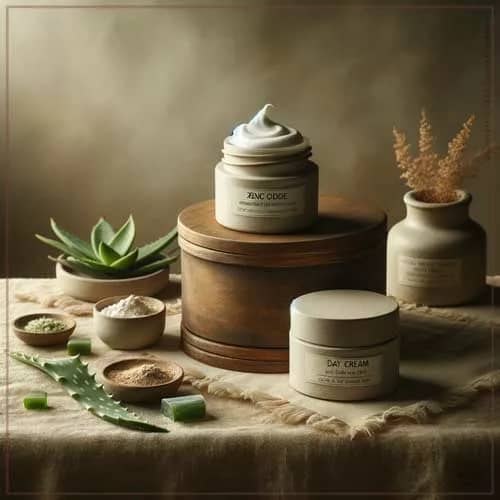
Welcome to a skincare journey where simplicity meets efficacy! If you’re navigating the tricky waters of acne-prone skin while trying to protect yourself from the sun’s rays, you’ve come to the right place. Today, I’m thrilled to share insights into crafting your very own DIY day cream that not only shields your skin from harmful UV rays but also caters to the unique needs of acne-prone skin.
Table of Contents
Why DIY?
Creating your own skincare products is a deeply rewarding experience. It allows you to handpick natural, skin-loving ingredients, ensuring that what you’re applying is free from harsh chemicals and perfectly suited to your skin type. Plus, it’s a fun, creative process that gives you control over what you’re nourishing your skin with!
Understanding SPF in Skincare
SPF, or Sun Protection Factor, is crucial in any day cream. It helps protect your skin from UVB rays, known for causing sunburn and contributing to skin cancer. For acne-prone skin, choosing the right SPF ingredients is vital to avoid clogging pores or causing irritation.
Choosing the Right Ingredients
Selecting ingredients that are non-comedogenic and skin-friendly is key. Look for natural SPF sources like zinc oxide or red raspberry seed oil, which are gentle and effective. Combine these with skin-soothing elements like aloe vera or green tea to create a balanced, acne-friendly formula.
Equipment and Preparation
Before you begin, ensure you have all the necessary equipment, such as a double boiler, blender, and sterilized containers. Remember, cleanliness is as important in skincare formulation as it is in cooking!
Step-by-Step Guide
- Melting and Mixing: Start by gently melting your base ingredients. This could be oils, butters, or waxes.
- Incorporating SPF: Carefully mix in your chosen SPF ingredient, ensuring it’s evenly dispersed.
- Adding Soothing Agents: Introduce soothing and acne-fighting elements to the mix.
- Cooling and Setting: Once thoroughly mixed, transfer your cream into a container to cool and set.
- Labeling and Storing: Don’t forget to label your cream with the date made and store it appropriately.
Texture and Fragrance
Your day cream’s final texture can range from light and fluffy to rich and creamy, depending on your ingredients. Natural fragrances from essential oils can add a pleasant sensory experience, but remember to use them sparingly, especially for sensitive skin.
Application Tips
Applying your DIY cream effectively is as important as the ingredients themselves. Use clean fingers or a spatula, and remember, a little goes a long way!
Benefits of Your DIY Cream
- Customized to your skin’s needs.
- Free from harsh chemicals and preservatives.
- Packed with natural, nourishing ingredients.
Understanding Shelf Life
Homemade creams lack the preservatives found in commercial products, so their shelf life is shorter. Pay attention to how your cream looks and smells over time to ensure it’s still safe to use.
Day Cream Recipes with SPF for Acne-Prone Skin
1. Aloe & Zinc Day Cream
Equipment Needed:
- Double boiler
- Mixing spoon
- Digital scale
- Sterilized jar for storage
Ingredients:
- 3 tbsp Aloe Vera Gel
- 2 tbsp Zinc Oxide Powder (non-nano)
- 1 tbsp Jojoba Oil
- 1 tsp Vitamin E Oil
- 5 drops Tea Tree Essential Oil
Instructional Steps:
- In a double boiler, gently melt the jojoba oil.
- Gradually add zinc oxide, stirring continuously to avoid clumps.
- Remove from heat and slowly mix in the aloe vera gel.
- Stir in vitamin E and tea tree oil until well combined.
- Transfer to the sterilized jar and let it cool.
Final Texture and Smell:
- Texture: Creamy and smooth
- Smell: Mild, with a hint of tea tree
Yield: About 50 ml
Application Tips:
- Apply a thin layer every morning.
- Allow it to absorb for a few minutes before applying makeup.
Benefits:
- Zinc oxide provides natural SPF protection.
- Aloe vera and jojoba oil soothe acne-prone skin.
- Tea tree oil offers antibacterial properties.
Shelf Life: 3 months when stored in a cool, dry place.
2. Green Tea & Carrot Seed Oil Cream
Equipment Needed:
- Blender
- Fine mesh strainer
- Mixing bowl
- Sterilized container
Ingredients:
- ½ cup Green Tea (brewed and cooled)
- 2 tbsp Shea Butter
- 1 tsp Carrot Seed Oil
- 1 tbsp Emulsifying Wax
- 5 drops Lavender Essential Oil
Instructional Steps:
- Brew green tea and let it cool.
- In a double boiler, melt shea butter and emulsifying wax.
- Blend the cooled green tea and slowly add to the melted mixture.
- Stir in carrot seed oil and lavender essential oil.
- Pour into a container and allow to set.
Final Texture and Smell:
- Texture: Light and fluffy
- Smell: Subtle lavender with a fresh undertone
Yield: About 60 ml
Application Tips:
- Use sparingly, as a little goes a long way.
- Best applied after cleansing in the morning.
Benefits:
- Natural SPF from carrot seed oil.
- Green tea offers antioxidant benefits.
- Shea butter hydrates without clogging pores.
Shelf Life: 6 weeks in the refrigerator.
3. Cucumber & Coconut SPF Cream
Equipment Needed:
- Blender
- Fine mesh sieve
- Mixing bowl
- Sterilized cream jar
Ingredients:
- ¼ cup Fresh Cucumber Juice
- 2 tbsp Coconut Oil
- 1 tbsp Non-nano Zinc Oxide
- 1 tsp Beeswax
- 5 drops Chamomile Essential Oil
Instructional Steps:
- Juice the cucumber and strain using a fine mesh sieve.
- Melt beeswax and coconut oil in a double boiler.
- Remove from heat and slowly stir in cucumber juice and zinc oxide.
- Add chamomile essential oil and mix thoroughly.
- Pour into a jar and let it cool.
Final Texture and Smell:
- Texture: Rich and hydrating
- Smell: Fresh cucumber with a hint of chamomile
Yield: About 50 ml
Application Tips:
- Best used in the morning after toning.
- Allow it to sink in before layering other products.
Benefits:
- Hydration from coconut oil.
- Zinc oxide for sun protection.
- Cucumber and chamomile soothe irritated skin.
Shelf Life: 4 weeks in the refrigerator.
4. Red Raspberry Seed & Honey Cream
Equipment Needed:
- Double boiler
- Whisk
- Sterilized cream jar
Ingredients:
- 2 tbsp Red Raspberry Seed Oil
- 1 tbsp Honey
- 1 tbsp Non-nano Zinc Oxide
- 2 tbsp Aloe Vera Gel
- 5 drops Rosemary Essential Oil
Instructional Steps:
- Warm honey in a double boiler until liquid.
- Add red raspberry seed oil and zinc oxide, whisking constantly.
- Remove from heat and stir in aloe vera gel.
- Finally, incorporate rosemary essential oil.
- Pour into a jar and allow to cool.
Final Texture and Smell:
- Texture: Silky and light
- Smell: Sweet with a hint of rosemary
Yield: About 60 ml
Application Tips:
- Apply a small amount each morning.
- Works well under makeup or alone.
Benefits:
- Natural SPF from red raspberry seed oil.
- Honey and aloe vera hydrate and calm the skin.
- Antioxidant properties from rosemary oil.
Shelf Life: 2 months in a cool, dry place.
5. Oatmeal & Avocado Protective Cream
Equipment Needed:
- Blender
- Mixing bowl
- Double boiler
- Sterilized storage container
Ingredients:
- 1 tbsp Oatmeal (finely ground)
- 2 tbsp Avocado Oil
- 1 tbsp Zinc Oxide Powder
- 1 tsp Shea Butter
- 5 drops Frankincense Essential Oil
Instructional Steps:
- Grind oatmeal into a fine powder.
- In a double boiler, melt shea butter and avocado oil.
- Stir in zinc oxide and ground oatmeal.
- Once cooled, add frankincense essential oil.
- Transfer to a container and let it set.
Final Texture and Smell:
- Texture: Creamy and nourishing
- Smell: Earthy with a hint of frankincense
Yield: About 50 ml
Application Tips:
- Gently apply in the morning after cleansing.
- Can be used as a base for makeup.
Benefits:
- Zinc oxide for sun protection.
- Oatmeal soothes and reduces redness.
- Avocado oil nourishes without aggravating acne.
Shelf Life: 3 months in a cool, dry place.
Empowering Your Skincare Routine
Embarking on the DIY skincare path is not just about creating a product; it’s about understanding and caring for your skin at a deeper level. With your homemade day cream, you’re not just applying a product; you’re embracing a lifestyle of conscious, customized skincare.
FAQ’s
How do you make sunscreen for acne-prone skin?
Creating sunscreen for acne-prone skin involves selecting non-comedogenic (non-pore clogging) ingredients that offer sun protection while being gentle on the skin. A basic formula would include a combination of a natural SPF ingredient, like zinc oxide, with skin-soothing components such as aloe vera or green tea extract. It’s crucial to ensure that the sunscreen is lightweight and free from heavy oils that could exacerbate acne.
What ingredients are in sunscreen for acne-prone skin?
Sunscreen for acne-prone skin typically contains ingredients that are both effective in sun protection and gentle on the skin. Key ingredients include:
- Zinc Oxide or Titanium Dioxide: Natural minerals that provide broad-spectrum sun protection without irritating the skin.
- Niacinamide (Vitamin B3): Helps reduce skin inflammation and redness.
- Hyaluronic Acid: For hydration without clogging pores.
- Salicylic Acid: Aids in unclogging pores, but should be used cautiously as it can be drying.
Is coconut oil considered a sunscreen?
Coconut oil is not considered an effective sunscreen. While it has some minimal natural SPF properties, it does not provide sufficient protection against the full spectrum of harmful UV rays. It’s always recommended to use ingredients like zinc oxide or titanium dioxide for reliable sun protection.
Is SPF 30 or 50 better for acne?
For acne-prone skin, SPF 30 is often sufficient and can be less irritating than SPF 50, especially for daily use. SPF 30 blocks about 97% of UVB rays, while SPF 50 blocks about 98%. The key is to find a formula that balances protection with gentleness to avoid irritating acne-prone skin.
Can too much SPF cause acne?
Using a high SPF product in itself does not cause acne, but the formulation of the sunscreen can. Some sunscreens contain oils and other ingredients that may clog pores, leading to breakouts. It’s important for individuals with acne-prone skin to choose sunscreens that are labeled as non-comedogenic and are free from pore-clogging ingredients.
Join the Conversation and Share Your Insights
Your Voice Matters in Our Community As we journey together in the world of DIY skincare, your experiences, insights, and recipes are invaluable. Whether you’re a seasoned DIY enthusiast or just beginning your natural skincare adventure, I’d love to hear from you.



